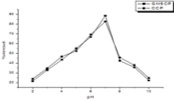Abstract
Removal of Pregabalin from aqueous solution as well as industrial effluent using a new, efficient and cost-effective activated carbon derived from groundnut seed cake powder (GNSCP) and coconut cake powder (CCP) has been presented in this study. Experimentation has been carried out by optimizing various parameters such as pH, contact time, dosage, temperature and initial drug concentration using a batch adsorption model. Surface texture and morphology of the activated carbons have been analyzed by HR SEM; Characterization of the adsorbents has been carried out using FTIR and PXRD. Bio-sorption of Pregabalin using GNSCP and CCP followed pseudo-second-order kinetics. Langmuir adsorption isotherm suits the best for the present study. Thermodynamic studies showed that the adsorption of the drug onto the chosen adsorbents is a spontaneous and feasible process. The maximum adsorption capacity for the uptake of Pregabalin by GNSCP was found to be 9.71 mg/g and with CCP 9.83 mg/g. Suitability of the adsorbents for the treatment of industrial effluent has also been carried out and found to have 98 % removal of the drug from the effluent.
Full text article
References
Avinash, M.K., Kumar, G.P., Bharath, Y., Rao, K.S. 2019. Removal of hexavalent chromium from aqueous solution using low-cost adsorbents and ANN modeling for prediction. Journal of Indian Chemical Society, 96:1–8.
Boukhelkhal, A., Benkortbi, O., Hamadache, M., Ghalem, N., Hanini, S., Amrane, A. 2016. Adsorptive removal of amoxicillin from wastewater using wheat grains: equilibrium, kinetic, thermodynamic studies and mass transfer. Desalination and Water Treatment, 57(56):27035–27047.
Brodin, T., Fick, J., Jonsson, M., Klaminder, J. 2013. Dilute Concentrations of a Psychiatric Drug Alter Behavior of Fish from Natural Populations. Science, 339(6121):814–815.
Calisto, V., Esteves, V. I. 2009. Psychiatric pharmaceuticals in the environment. Chemosphere, 77(10):1257–1274.
Cheng, X. Q., Zhang, C., Wang, Z. X., Shao, L., Tailoring 2016. Tailoring nano-filtration membrane performance for highly efficient antibiotics removal by mussel-inspired modification. Journal of Membrane Science, 499:326–334.
Comerton, A.M., Andrews, R.C. 2007. Membrane adsorption of endocrine-disrupting compounds and pharmaceutically active compounds. Journal of Membrane Science, 303(1):267–277.
El-taliawy, H., Ekblad, M., Nilsson, F., Hagman, M., Paxeus, N., Jönsson, K., Cimbritz, M., la Cour Jansen, J., Bester, K. 2017. Ozonation efficiency in removing organic micro pollutants from wastewater with respect to hydraulic loading rates and different wastewaters. Chemical Engineering Journal, 325:310–321.
Guler, Y., Ford, A. T. 2010. Anti-depressants make amphipods see the light. Aquatic Toxicology, 99(3):397–404.
Ji, Y., Fan, Y., Liu, K., Kong, D., Lu, J. 2015. Thermo activated persulfate oxidation of antibiotic sulfamethoxazole and structurally related compounds. Water Research, 87:1–9.
Kumar, G.P., Avinash, M.K., Bharath, Y., Rao, K.S. 2020. Withdrawal of Mn (II) from aqueous solution using low-cost adsorbents: isothermal, kinetic and ANN modeling studies. Journal of Indian Chemical Society, 97(6):1–3.
Kumar, S.P., Kumar, G.P., Rao, K.S. 2019. Utilization of three low-cost bio adsorbents in their native as well as carbonized form in the removal of Co (II) from aqueous solutions. Journal of Indian Chemical Society, 96:399–405.
McCallum, E. A., Hyung, H., Do, T., Huang, C., Kim, J. 2008. Adsorption, desorption, and steady-state removal of 17β-estradiol by nanofiltration membranes. Journal of Membrane Science, 319(1- 2):38–43.
Rivera-Utrilla, J., Sánchez-Polo, M., Ángeles Ferro-García, M., Prados-Joya, G., Ocampo-Pérez, R. 2013. Pharmaceuticals as emerging contaminants and their removal from water. A review. Chemosphere, 93(7):1268–1287.
Ternes, T.A., Janex-Habibi, M.L., Knacker, T., Kreuzinger, N., Siegrist, H. 2004. Assessment of Technologies for the Removal of Pharmaceuticals and Personal Care Products in Sewage and Drinking Water Facilities to Improve the Indirect, Potable Water Reuse. Poseidon, pages 1–61.
Authors

This work is licensed under a Creative Commons Attribution-NonCommercial-NoDerivatives 4.0 International License.

